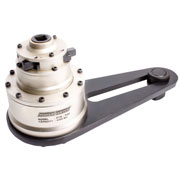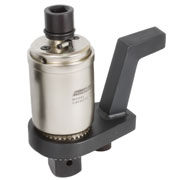Torque Multipliers
How They Work
Hand Torque Multipliers incorporate an ‘Epicyclic’ or ‘Planetary’ gear train with one or more stages. Each stage of gearing increases the torque applied by a factor of 5, allowing to offer torque multipliers in ratios of 5:1, 25:1 and 125:1. In the planetary gear system, the torque is applied to the input gear or ‘Sun’ gear. Three or four planet gears, with teeth engaged in the sun gear, rotate. The outside casing of the torque multiplier, or ‘Annulus’ is also engaged with the planet gear teeth, and would normally rotate in the opposite direction from the sun gear. A reaction arm prevents the annulus from rotating, and this causes the planet gears to orbit around the sun gear. The planet gears are held between input and output plates which also hold the output square drive. Therefore as the planetary gears orbit around the sun gear, the output plate and the square drive turn. To be noted: Without the reaction arm to keep the annulus stationary, the output square will not apply torque.
What is a Mechanical Torque Multiplier?
It is a simple gear box, works on the principle of ‘Epicyclic Gearing’. The given load at the input gets multiplied as per the multiplication factor and transmitted at the output, thereby achieving a greater load with a minimum effort.
Why use a Mechanical Torque Multiplier?
- Safety - Using of long levers can be dangerous. Torque Multipliers mean a reduction in the lever length or the operator effort by a factor of 5, 25 or 125.
- Space Limitation - The use of a long lever may be impossible due to restricted space.
- Accuracy - Torque will be applied most accurately when it is applied smoothly and slowly. Torque Multipliers enable this by removing much of the physical effort from the tightening task.
People Also Ask
1.
Where are POWERMASTER LTD mechanical torque multipliers used for?
POWERMASTER LTD Mechanical torque multipliers are used to increase the torque applied to a fastener, making it easier to tighten or loosen bolts that require higher torque than can be applied manually. These tools are particularly useful in industries where heavy-duty bolting is required.
2.
What is the difference between electrical torque and mechanical torque?
Mechanical torque is created when physical force is given to rotating items, such as gears or shafts, whereas electrical torque is produced by an electric motor using magnetic fields. Electrical torque is connected to powered systems, whereas mechanical torque is frequently used with hand or hydraulic equipment.
3.
What is the principle of torque multiplier?
A torque multiplier operates on the principle of gear reduction, where a lower input force turns a series of gears, multiplying the torque applied at the output. This allows for the application of high torque with less physical effort, improving efficiency in tightening or loosening fasteners.


